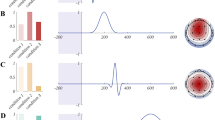Abstract
Changes in the EEG depend on the style of accompanying music. Classical music produces more patterns with increased diagonal coherences in the γ frequency band, where two foci of integration are formed at points T 4 and T 6. During listening to rock music, a larger proportion of all changes occurred in the θ-and α1 frequency bands; an integration focus was formed at point T 6 in the α1 and γ frequency bands. An increase in diagonal coherences that was observed during the recognition was especially pronounced in the Δ-, θ-and α1 frequency bands. In addition, there was an increase in the coherence between the potentials recorded at points O 1-P 4 and O 2-F 7, and it was observed in all the frequency bands. During the recognition of masked visual images accompanied by classical or rock music, there were more patterns with an increased diagonal coherence of the currently dominant activity. Before erroneous recognition, a widely generalized increase in coherence over the brain cortex was observed in the Δ, θ, and α1 bands, which was an informative indicator of the subsequent erroneous recognition. In tests with recognition unaccompanied by music, as well as with music, the main change in symmetrical coherences was either a decrease in or an absence of changes in this indicator versus the background value.
Similar content being viewed by others
References
Pavlygina, R.A., Frolov, M.V., Davydov, V.I., et al., The Recognition of Visual Images in a Sensorily Enriched Environment: Musical Accompaniment, Zh. Vyssh. Nervn. Deyat., 1998, vol. 48, no. 1, p. 19.
Sakharov, D.S., Davydov, V.I., and Pavlygina, R.A., Intercentral Relationships of the Human EEG during Listening to Music, Fiziol. Chel., 2005, vol. 31, no. 4, p. 27 [Hum. Physiol. (Eng. Transl.), 2005, vol. 31, no. 4, p. 392].
Pavlygina, R.A., Sakharov, D.S., and Davydov, V.I., The Human EEG in Recognition of Masked Visual Images Accompanied by Music, Fiziol. Chel., 2007, vol. 33, no. 6, p. 35 [Hum. Physiol. (Eng. Transl.), 2007, vol. 33, no. 6, p. 696].
Pavlygina, R.A., Sakharov, D.S., and Davydov, V.I., Spectral Analysis of the Human EEG during Listening to Musical Compositions, Fiziol. Chel., 2004, vol. 30, no. 1, p. 62 [Hum. Physiol. (Eng. Transl.), 2004, vol. 30, no. 1, p. 52].
Giannitrapani, D., Scanning Mechanisms and the EEG, EEG Clin. Neurophysiol., 1971, vol. 30, no. 2, p. 139.
Nikolaev, A.R., Anokhin, A.P., Ivanitskii, G.A., et al., Spectral Reorganizations in the EEG and Organization of Cortical Links in Spatial and Verbal Thinking, Zh. Vyssh. Nervn. Deyat., 1996, vol. 46, no. 5, p. 831.
Ray, W.J., Cole, H.W., EEG Activity during Cognitive Processing: Influence of Attention Factors, Int. J. Phychophysiol., 1985, vol. 3, no. 1, p. 43.
Danilova, N.N., Microstructural Analysis of the γ Rhythm as a Method to Study Cognitive Processes, in Problemy neirokibernetiki (Problems in Neurocybernetics), Rostov-on-Don: TsVVR, 2005, vol. 1, p. 16.
Simonov, P.V., Emotsional’nyi mozg (The Emotional Brain), Moscow, Nauka, 1981.
Sviderskaya, N.E., Prudnikov, V.N., Antonov, A.G., The Specificities of Human EEG Anxiety Signs, Zh. Vyssh. Nervn. Deyat., 2001, vol. 51, no. 2, p. 158.
Dubrovinskaya, N.V., Neirofiziologicheskie mekhanizmy vnimaniya: Ontogeneticheskoe issledovanie) Neurophysiological Mechanisms of Attention: An Ontogenetic Study), Leningrad: Nauka, 1985.
Besson, M., Faita, F., and Requin, J., Brain Waves Associated with Musical Incongruities Differ for Musicians and Non-musicians, Neurosci. Lett., 1994, vol. 168, nos. 1–2, p. 101.
Spies, K., Hesse, F.W., Gerrards-Hesse, A., and Ueffing, E., Experimental Induction of Emotional States: Does Addition of Music Improve Self-Disclosure? Z. Exp. Angew. Psychol., 1991, vol. 38, no. 2, p. 321.
Bradshaw, J.L. and Nettleton, W.C., The Nature of Hemispheric Specialization in Man, Behav. Brain Sci., 1981, vol. 4, no. 1, p. 51.
Nakada, T., Fujii, Y., Suzuki, K., and Kwee, I.I., Musical Brain” Revealed by High-Field (3 Tesla) Functional MRI, Neuro-Report, 1998, vol. 9, p. 3853.
Potulova, L.A. and Korinevskii, A.V., Parameters of Prestimulus EEG in Recognition of a Significant Light Stimulus by an Operator, Zh. Vyssh. Nervn. Deyat., 1986, vol. 36, no. 2, p. 302.
Rusinov, V.S., Grindel’, O.M., Boldyreva, G.N., and Vakar, E.M., Biopotentsialy mozga cheloveka: Matematicheskii analiz (Human Brain Bioelectric Potentials: Mathematical Analysis), Moscow: Meditsina, 1987.
Zhavoronkova, L.A., Specificities of Interhemispheric EEG Asymmetry in Right-Handed and Left-Handed People as a Reflection of Interaction Between the Brain Cortex and Regulatory Brain Structures, Dokl. Akad. Nauk, 2000, vol. 375, no. 5, p. 696.
Kozhedub, R.G., Sviderskaya, N.E., and Taratynova, G.V., Spatial Organization of Bioelectric Potentials and Originality of Visual Images, Zh. Vyssh. Nervn. Deyat., 2006, vol. 56, no. 4, p. 437.
Boldyreva, G.N., Sharova, E.V., Koptelov, Yu.M., et al., Study of the Genesis of the Pathological EEG Patterns in Tumors and Traumatic Lesions of the Human Brain, Fiziol. Chel., 2005, vol. 31, no. 1, p. 24 [Hum. Physiol. (Eng. Transl.), 2005, vol. 31, no. 1, p. 18].
Boldyreva, G.N., Elektricheskaya aktivnost’ mozga cheloveka pri porazhenii dientsfel’nykh i limbicheskikh struktur (Electrical Activity of the Human Brain in Lesion of Diencephalic and Limbic Structure), Moscow, Nauka, 2000.
Blood, A.J. and Zatorre, R.J., Intensely Pleasurable Responses to Music Correlate With Activity in Brain Regions Implicated in Reward and Emotion, Proc. Natl. Acad. Sci. USA, 2001, vol. 98, no. 20, p. 11818.
Author information
Authors and Affiliations
Additional information
Original Russian Tex © R.A. Pavlygina, D.S. Sakharov, V.I. Davydov, 2008, published in Fiziologiya Cheloveka, 2008, Vol. 34, No. 4, pp. 11–18.
Rights and permissions
About this article
Cite this article
Pavlygina, R.A., Sakharov, D.S. & Davydov, V.I. Interhemispheric EEG interrelations in recognition of masked visual images accompanied by music. Hum Physiol 34, 397–404 (2008). https://doi.org/10.1134/S0362119708040026
Received:
Published:
Issue Date:
DOI: https://doi.org/10.1134/S0362119708040026




